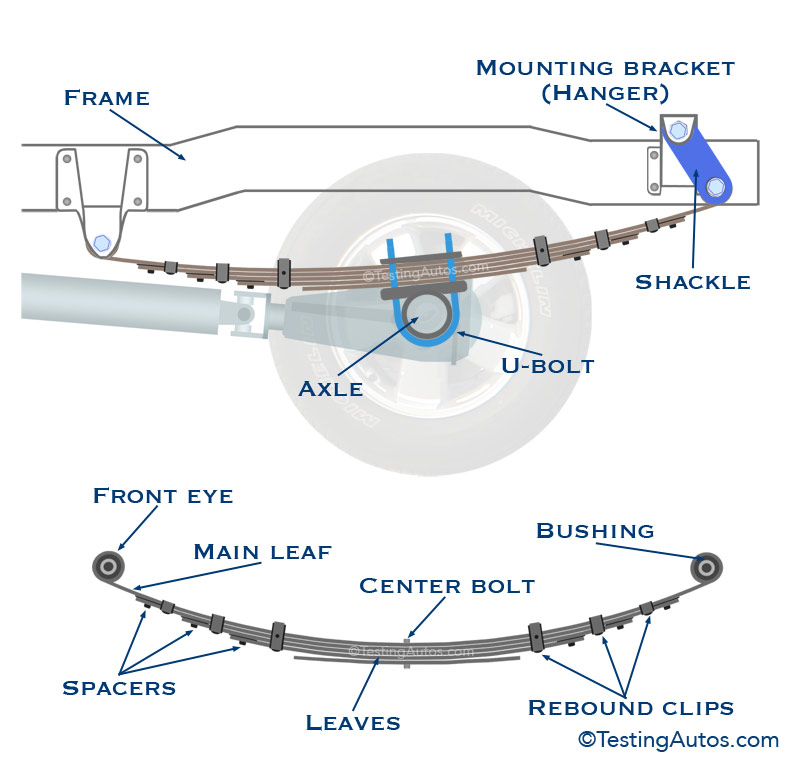Have you ever noticed your vehicle feeling a bit less stable or sagging under heavy loads? The culprit might be your leaf springs.
These essential components play a crucial role in maintaining your vehicle’s suspension, ensuring a smooth and balanced ride. But like all parts, they wear out over time. Understanding how to change leaf springs can save you time, money, and perhaps even a trip to the mechanic.
In this guide, we’ll walk you through the process step by step, making it simple and straightforward. You’ll discover when it’s time to change those springs, and just how manageable this task can be, even if you’re not a seasoned mechanic. Ready to dive in and boost your vehicle’s performance? Let’s get started!

Credit: www.testingautos.com
When To Change Leaf Springs
Change leaf springs when you notice sagging, uneven tire wear, or a rough ride. Regular inspection helps spot these signs early. Proper maintenance ensures a smoother, safer driving experience.
Leaf springs are vital components in vehicles. They ensure a smooth ride and support heavy loads. But like any part, they wear out. Knowing when to replace them is key to maintaining vehicle performance and safety. Signs of Wear Sometimes, leaf springs show signs of wear.
Recognizing these indicators can prevent further damage. – Sagging: The vehicle sits lower than usual. This suggests weakened springs. – Noise: Unusual sounds during driving. These may indicate broken leaves. – Uneven tire wear: Tires show irregular patterns. This could mean suspension issues.
– Rust: Visible corrosion on springs. This weakens their structural integrity. Impact on Vehicle Performance Worn leaf springs affect how your vehicle handles. Here’s how: – Stability: Reduced control during turns or over bumps. – Load capacity: Decreased ability to carry heavy loads safely.
– Ride comfort: Increased roughness and vibration felt inside the vehicle. Safety Concerns Driving with damaged leaf springs poses risks. Ensuring your safety is crucial. – Braking: Compromised braking efficiency. This makes stopping less predictable. – Steering: Difficulty in maintaining direction.
This can lead to accidents. – Suspension: Increased stress on other suspension parts. This accelerates wear. Inspection Frequency Regular checks help catch issues early. Here’s when to inspect leaf springs: – Annual maintenance: Routine vehicle servicing includes suspension inspection. – After heavy loads: Check springs after transporting large weights.
– Long trips: Inspect after lengthy journeys, especially on rough terrain. Professional Assessment Consulting a mechanic provides expert insights. Here’s why it’s beneficial: – Expertise: Mechanics identify problems accurately. They recommend suitable solutions. – Equipment: Professional tools ensure precise evaluations.
– Safety: Ensures the vehicle remains safe to drive.
Are Leaf Springs Hard To Change
Changing leaf springs can be challenging but manageable with proper tools and guidance. First, secure the vehicle safely. Next, remove the old springs by loosening bolts. Finally, install new springs, ensuring they are aligned correctly. This task requires patience and attention to detail for a successful replacement.
Changing leaf springs can seem daunting at first glance. These components play a crucial role in your vehicle’s suspension system, providing stability and support. With the right tools and knowledge, replacing leaf springs can become a manageable task. Let’s explore whether leaf springs are difficult to change and how you can tackle this project effectively.
Understanding Leaf Springs Leaf springs are vital in absorbing shock and ensuring smooth rides. These elongated strips of metal stack together, providing structural support. Their design allows them to bend and flex, adapting to road conditions. Are Leaf Springs Hard to Change?
Many wonder about the difficulty of changing leaf springs. It varies based on several factors: – Experience level: Those familiar with car maintenance may find it easier. – Tools required: Proper tools simplify the process. – Vehicle type: Some vehicles have more accessible suspension systems.
– Condition of current springs: Rusty or damaged springs complicate removal. Preparing for Replacement Preparation is key for this project. Start by gathering necessary tools and equipment. Ensure you have a safe workspace and follow these steps: – Safety precautions: Always wear protective gear.
– Vehicle elevation: Use jacks or ramps to lift the vehicle. – Inspection: Check current springs for wear and tear. Step-by-Step Guide Ready to start? Here’s a simple guide to changing leaf springs: 1. Remove the old springs: Begin by loosening bolts and brackets.
2. Install new springs: Position them correctly before securing. 3. Tighten connections: Ensure all nuts and bolts are secure. 4. Check alignment: Confirm the springs are properly aligned. Changing leaf springs might seem challenging, but with patience and preparation, you can tackle it effectively.
Following these steps will help ensure a smooth and successful replacement.

Credit: www.youtube.com
Conclusion
Changing leaf springs can seem tough, but it’s doable with patience. Regular checks can help spot wear early. Replace when springs sag or crack. Gather the right tools and follow steps carefully. Safety first! Remember, proper maintenance extends your vehicle’s life.
DIY saves money and builds skills. Start small if you’re new to car repairs. Practice makes perfect. A well-maintained vehicle keeps you safe on the road. Take your time and enjoy learning. You’ll gain confidence with each repair. Happy fixing and safe travels!
